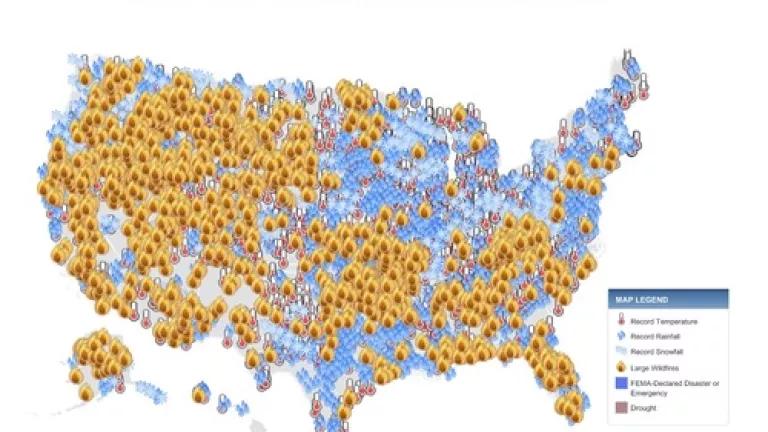
Last July, Rod Berning stood in the midst of withering corn stalks on his farm in western Kansas and told my colleagues, “The climate is changing. The storms aren’t coming as frequent as they did. There’s no normal anymore.” Berning said those words in the midst of the hottest July on record and the worst U.S. drought in 50 years. Six months later, the drought is still making its presence known. Many farmers and ranchers haven’t gotten the rain they need to recover, and the Mississippi River is running so low it could be closed for shipping.
This devastating drought is enough to make 2012 go down in history. But it is just one of several record-breaking extreme weather events that hammered our communities last year.
NRDC experts analyzed government weather data and found that at least 3,527 monthly weather records were broken for heat, rain, and snow throughout the United States last year. That is higher than the 3,251 records smashed in 2011. You can click here to see an interactive map and learn more about extreme weather in your home state.
Many of these new records brought suffering and destruction in their wake. More than 100 million Americans were under some form of heat advisory as temperatures spiked in communities from Brownsville to New York last summer. The nearly 14-foot storm surges during Hurricane Sandy broke all-time records for New York Harbor and contributed to the deaths of 131 people. And out West, the average size of wildfires hit new highs and destroyed hundreds of homes in the process.
Taken together, these broken records reveal a clear picture: this is what climate change looks like. Scientists from the National Center for Atmospheric Research, the National Oceanic and Atmospheric Administration, and other leading groups confirm that climate change creates stronger storms, more potent heat waves, and more searing drought.
On Friday a federal advisory panel—established by Congress in 1990 to analyze climate research—released the draft of its third National Climatic Assessment. The report confirmed there is “unambiguous evidence” that the earth is warming. “Certain types of weather events,” the panel concluded, “have become more frequent and/or intense, including heat waves, heavy downpours, and, in some regions, floods and droughts. Sea level is rising, oceans are becoming more acidic, and glaciers and arctic sea ice are melting.”
This report followed on the heels of NOAA’s National Climate Data Center announcement that 2012 was the hottest year on record for the contiguous United States. The center also said 11 disasters topped the $1 billion mark in losses last year. Munich Re recently confirmed the spike in extreme weather damage: more than 90 percent of the world’s insured weather disaster costs in 2012 occurred in the United States.
The evidence is undeniable: extreme weather events are pounding our communities and if we don’t curb climate change, many will grow more severe. We don’t have to let this happen. We can call on President Obama to use tools at his disposal to fight climate change right now.
Just last month, NRDC experts unveiled a flexible, cost-effective proposal for how the Environmental Protection Agency could cut carbon pollution from existing power plants—the nation’s largest source of climate-changing pollution. This plan would cut carbon pollution 26 percent by 2020. It would also generate an estimated $25 billion to $60 billion in health and climate benefits, far outstripping the projected cost of $4 billion in 2020.
This is the kind of concrete action we can take to help protect our communities from the ravages of extreme weather. Click here to tell President Obama limit carbon pollution from power plants now.



